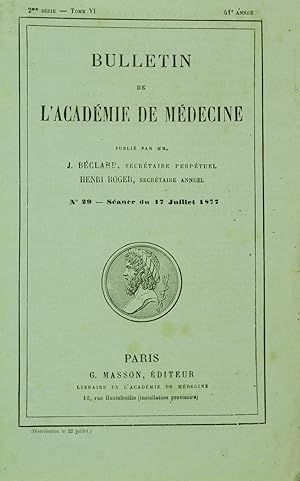About this Item
Paris, 1877 ; 1 fascicule in-8 (22.5 x 14 cm), pp. 775-798, broché, couverture verte imprimée, rares rousseurs, très bon état. Edition originale très rare de ce fascicule. L'importante communication de Pasteur et Joubert en occupe la presque totalité, à savoir les pages 781-798 : *** PASTEUR?S GROUND-BREAKING DISCOVERY OF ANTIBIOSIS WITH ITS PRACTICAL IMPLICATIONS *** Pasteur avait déjà fait cette communication la veille, 16 juillet, devant l'Académie des Sciences. Le texte du 17 juillet, proposé ici, est augmenté d'environ 1 page, Pasteur en profitant pour condamner la doctrine médicale de "la spontanéité de toutes les maladies", dont Bastian (professeur à l'University College of London) était un des principaux adeptes. Ce texte est riche en données novatrices. La plus importante est sans doute la découverte de l'antibiose (Pasteur et Joubert observant un antagonisme entre la bactéridie charbonneuse et d'autres bactéries). REFERENCES: Garrison & Morton, 1932.1 et 2490 (publication dans C.R. Acad. Sci): "Pasteur and Joubert were probably the first to realize the practical implications of antibiosis. They noted the antagonism between Bacillus anthracis and other bacteria in cultures." - "Discovery of Vibrion septique (Cl. Septicum), the first pathogenic anaerobe to be found" ; Kon K & Rai M: Antibiotic resistance, p. 19: "Discovering the first antibiotics: In 1877, the French microbiologists Louis Pasteur and Jules François Joubert published the results of a classic experiment using anthrax bacilli showing that they did not grow significantly in animals coinfected with other pathogenic bacteria." ; Sams ER, Whiteley M & Turner KH: 'The battle for life': Pasteur, anthrax, and the first probiotics, J Med Microbiol. 2014, 63(Pt 11), 1573-4: " 'Charbon et septicemie' is a long report. What we found most interesting and enjoyable about 'Charbon et septicemie' was how, in hindsight, the report contains so many glimpses of the future, both for Pasteur and for the field of microbiology. Pasteur?s confirmation that the anthrax bacillus is responsible for the illness, as well as his work isolating it in pure culture, laid the groundwork for one of his most famous experiments 4 years later: the public demonstration of the anthrax vaccine in Pouilly-le-Fort.We were also particularly intrigued by a brief mention of an experiment performed by Pasteur and Joubert in 'Charbon et septicemie': Remarkably one can introduce the anthrax bacillus in abundance in an animal without the animal contracting anthrax so long as the liquid that holds in suspension the bacillus also contains common bacteria. These facts tentatively give rise to the greatest hopes from a therapeutic perspective. Thus, some of the first work on the germ theory of disease also contained the first mentions of probiotics, although you would be unlikely to find these organisms in the health aisle of your grocery store. Pasteur argued that the antagonistic effect of other microbes on the anthrax bacillus was attributable to the 'battle for life', loosely defined by him as competition for limited oxygen. Yet, 12 years later, work by Charrin and Guignard proved him at least partially wrong. 'Charbon et septicemie' is remarkable mainly for its historical context. The main scientific advancement Pasteur reports is, in retrospect, an incremental advance on the work of Koch less than a year prior. Yet the report itself describes the challenges facing medical microbiology in the 1870s, and vividly illuminates the process of science at the time. This report was published when the worlds of laboratory microbiology and medicine were just beginning to converge, and, like Pasteur himself, it has a foot placed squarely in both of these worlds." ; Collard PJ & Collard P: The Development of Microbiology, p. 67 ; Pommerville J: Fundamentals of Microbiology, pp. 347, 349 ; Bulloch W: The history of bacteriology, pp. 212-213. © S.A.S. Jean-Pierre Aubert, 2017.
Seller Inventory # 1201-77-4
Contact seller
Report this item
